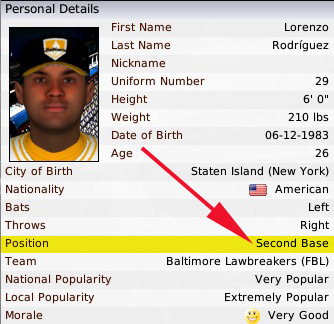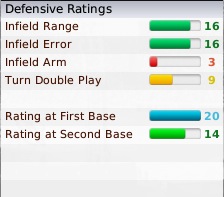| Find in this manual | ||
| Replace with | ||
Player Positions and Roles
Each player in OOTP has a single assigned position that is displayed on the Player Profile, on player lists that show player positions, and in various reports.

A player can only have one assigned position at a time. Think of it as where the organization plans to play him. However, the assigned position has no impact on where a player actually has to play. You could place a pitcher in left field or a third baseman at first base, if you so desired. The assigned position is just a way of labeling the player for easy reference.

In the example above, the player is an outstanding first baseman and a fair second baseman. Because he has ratings at these positions, he can play any of those positions without suffering any undue penalties. This player might have an assigned position of first base, but he could well be your best second baseman, too!
OOTP follows the concept of the "defensive spectrum." The defensive spectrum is as follows: DH - 1B - LF - RF - 3B - CF - 2B - SS. Generally speaking, the further to the right, the harder the position is to play and the harder it will be to convert a player to that position. Position players can learn to play catcher, but it often takes a very long time, and they typically don't make very good ones.
Note: A player cannot 'lose' positions. Once he has learned a position, he will always have a rating at that position.
Again, there's no reason you can't put a MR into your starting rotation. However, note that news articles involving pitchers will use the pitcher's role to decide what kind of information to present. News articles about starters are likely to include wins and losses, for example, while news articles about closers are likely to mention saves.

A player can only have one assigned position at a time. Think of it as where the organization plans to play him. However, the assigned position has no impact on where a player actually has to play. You could place a pitcher in left field or a third baseman at first base, if you so desired. The assigned position is just a way of labeling the player for easy reference.
Changing a Player's Assigned Position
You can change a player's assigned position by using the Set Position To... action menu that is available at the bottom of everyscreenin the Player Profile. Commissioners can also change player positions through the Player Editor.Player Ratings at Multiple Positions
As described in the Defensive Ratings section, players receive a numeric rating at any position they are qualified to play. A single player may have ratings at one, three, or even nine positions. So, a player's assigned position isn't necessarily the only position he can play. In fact, it may not even be his best position. For example, you might have a good third baseman who plays an average shortstop, but you also have an All-Star third baseman. So, you have the All-Star play third, while the first player plays short. In this case, his assigned position could be 3B OR SS - it doesn't really matter which. Player ratings at each position can be seen on the Player Profile, the Ratings page, or in any player list using the Position Ratings view.
In the example above, the player is an outstanding first baseman and a fair second baseman. Because he has ratings at these positions, he can play any of those positions without suffering any undue penalties. This player might have an assigned position of first base, but he could well be your best second baseman, too!
Playing out of Position
Even if your player does not have a rating at a position, you can still play him at any position in a game. Just place him wherever you would like in your lineup or depth chart. You could even place a second baseman in your pitching rotation, although he's not likely to do well. However, a player who is not rated at a position is well below average in his ability at that position, and is likely to have poor range and make frequent errors.Learning New Positions
Players learn new positions through practice. The best way to accomplish this is by having them play in a new position. Players learn more quickly when they play regularly in the minor leagues, or in spring training. The more a player plays at a certain position, the more he improves. After he has acquired a certain amount of experience at a position, he will be given a position rating that will display on his profile.OOTP follows the concept of the "defensive spectrum." The defensive spectrum is as follows: DH - 1B - LF - RF - 3B - CF - 2B - SS. Generally speaking, the further to the right, the harder the position is to play and the harder it will be to convert a player to that position. Position players can learn to play catcher, but it often takes a very long time, and they typically don't make very good ones.
Note: A player cannot 'lose' positions. Once he has learned a position, he will always have a rating at that position.
Pitching Roles
In addition to a position, pitchers also have a role, which can be set to one of three values: starting pitcher (SP), middle reliever (MR), or closer (CL). Just as with assigned positions, pitcher roles do not affect a pitcher's ability. (As mentioned in Pitching Ratings, relief pitchers gain a small bonus to stuff.) However, some pitchers might be better in certain roles. For example, pitchers with very low Stamina or few effective pitches make poor starting pitchers. Roles also play a part in how the computer managers make decisions. For example, the computer is unlikely to place a closer in a starting spot.Again, there's no reason you can't put a MR into your starting rotation. However, note that news articles involving pitchers will use the pitcher's role to decide what kind of information to present. News articles about starters are likely to include wins and losses, for example, while news articles about closers are likely to mention saves.